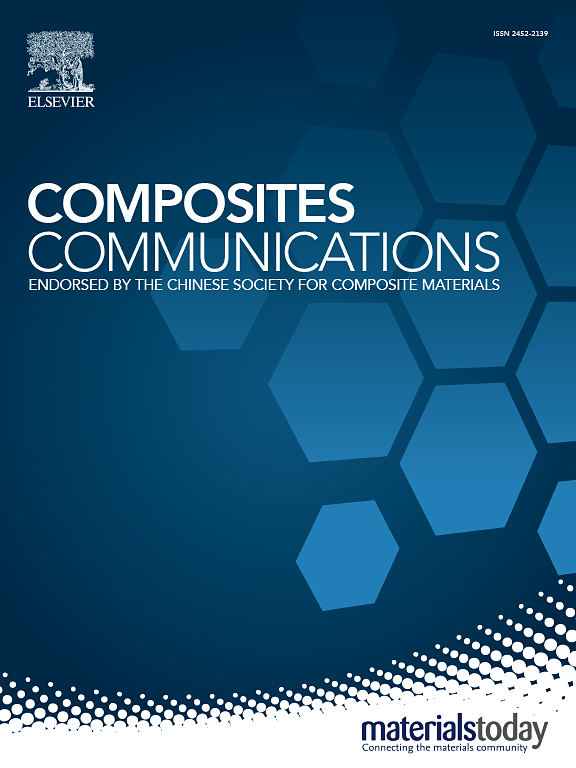Fire retardancy of epoxy composites: A comparative investigation on the influence of porous structure and transition metal of metal-organic framework
IF 7.7
2区 材料科学
Q1 MATERIALS SCIENCE, COMPOSITES
引用次数: 0
Abstract
Metal-organic frameworks (MOFs) are crystalline porous materials constructed by metal nodes and organic linkers. A series of key features such as high surface area, catalytic performance provide a platform for preparing MOF-based fire retardants (FRs). However, understanding the role of the porous structure and catalytic metal species remains a key issue towards the fire retardant mechanism of MOFs. This work systematically studied the difference between the performance of a zirconium based MOF(UiO-66), its derived porous zirconium oxide (U-ZrO2), and commercial ZrO2 (C-ZrO2), in imparting fire retardancy, suppressing smoke and charring property towards epoxy. With the presence of 3 wt% porous U-ZrO2, EP/3U-ZrO2 sample showed better performance in suppressing heat (10 % reduction) and toxic carbon monoxide (14 % reduction) than that of EP/3C-ZrO2 due to the “tortuous path” effect and formation of a compact char. Moreover, a greater number of exposed catalytic sites on MOF compared with thermally treated metal oxide significantly reduced total smoke production (TSP) of the EP/MOF sample by 38 %. Catalytic carbonization attributed to the great number of metal sites on MOF is crucial in providing compact char residue, thereby suppressing smoke for EP. In perspective, this work opens a window for understanding the fire retardant mechanism of MOF-based FR towards polymers.
环氧树脂复合材料的阻燃性:多孔结构和金属有机框架过渡金属影响的比较研究
金属有机框架(MOFs)是由金属节点和有机连接体构成的结晶多孔材料。它具有高比表面积和催化性能等一系列关键特性,为制备基于 MOF 的阻燃剂(FRs)提供了一个平台。然而,了解多孔结构和催化金属物种的作用仍是研究 MOFs 阻燃机制的关键问题。本研究系统研究了锆基 MOF(UiO-66)、其衍生的多孔氧化锆(U-ZrO2)和商用 ZrO2(C-ZrO2)在赋予环氧树脂阻燃性、抑烟性和炭化性方面的性能差异。由于存在 3 wt%的多孔 U-ZrO2,EP/3U-ZrO2 样品在抑制热量(减少 10%)和有毒一氧化碳(减少 14%)方面的性能优于 EP/3C-ZrO2,这是由于 "迂回路径 "效应和紧密炭的形成。此外,与热处理金属氧化物相比,MOF 上更多暴露的催化位点使 EP/MOF 样品的总烟雾产生量(TSP)显著减少了 38%。MOF上大量金属位点的催化碳化作用是提供致密炭渣的关键,从而抑制了 EP 的烟雾产生。总之,这项工作为了解基于 MOF 的阻燃剂对聚合物的阻燃机理打开了一扇窗。
本文章由计算机程序翻译,如有差异,请以英文原文为准。
求助全文
约1分钟内获得全文
求助全文
来源期刊

Composites Communications
Materials Science-Ceramics and Composites
CiteScore
12.10
自引率
10.00%
发文量
340
审稿时长
36 days
期刊介绍:
Composites Communications (Compos. Commun.) is a peer-reviewed journal publishing short communications and letters on the latest advances in composites science and technology. With a rapid review and publication process, its goal is to disseminate new knowledge promptly within the composites community. The journal welcomes manuscripts presenting creative concepts and new findings in design, state-of-the-art approaches in processing, synthesis, characterization, and mechanics modeling. In addition to traditional fiber-/particulate-reinforced engineering composites, it encourages submissions on composites with exceptional physical, mechanical, and fracture properties, as well as those with unique functions and significant application potential. This includes biomimetic and bio-inspired composites for biomedical applications, functional nano-composites for thermal management and energy applications, and composites designed for extreme service environments.
 求助内容:
求助内容: 应助结果提醒方式:
应助结果提醒方式:


